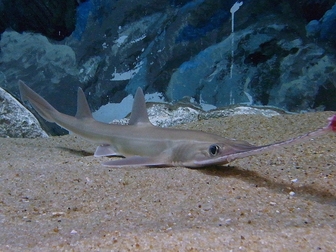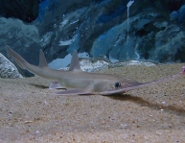Japanese sawshark
The Japanese sawshark, Pristiophorus japonicus, is a sawshark of the family Pristiophoridae, found in the northwest Pacific Ocean around Japan, Korea, and northern China between latitudes 48°N and 22°N, from the surface to 500 m.

Original source: http://opencage.info/pics.e/large_13173.asp Author OpenCago.info
Author: OpenCago.info Licensing This file is licensed under the
The Japanese sawshark lives in the demersal, marine, depth range 0 - 500 m environment.
The Japanese Sawshark ' the Samurai of the Ocean
 The Japanese sawshark (Pristiophorus japonicus) is one of the ocean's more bizarre-looking creatures. It has a flat snout, studded with teeth, which resembles a serrated saw. Protruding from the middle of the saw-like snout are two long, sensitive, whisker-like barbels. The sawshark uses these barbels, along with electro-receptors located on the underside of its saw ' which are known as ampullae of Lorenzini ' to help it find prey buried in the sand as it cruises along the bottom of the ocean. The Japanese sawfish typically feeds on fish, squid, shrimp and other crustaceans. Once it locates its prey, the Japanese sawfish will first use its snout to uncover its prey from the sand and then kill or maim it with savage slashes of its saw-like snout.
The Japanese sawshark (Pristiophorus japonicus) is one of the ocean's more bizarre-looking creatures. It has a flat snout, studded with teeth, which resembles a serrated saw. Protruding from the middle of the saw-like snout are two long, sensitive, whisker-like barbels. The sawshark uses these barbels, along with electro-receptors located on the underside of its saw ' which are known as ampullae of Lorenzini ' to help it find prey buried in the sand as it cruises along the bottom of the ocean. The Japanese sawfish typically feeds on fish, squid, shrimp and other crustaceans. Once it locates its prey, the Japanese sawfish will first use its snout to uncover its prey from the sand and then kill or maim it with savage slashes of its saw-like snout.
The Japanese sawshark is not a big shark and typically does not grow larger than one-and-half meters or six feet in length. It is sometimes mistaken for a similar looking creature known as the sawfish, which actually belongs to the ray family. Sawfish do not have barbels and the teeth located on its snout are all evenly sized, whereas the teeth of a sawshark alternate from big to little to big. In addition, the sawshark has gills on the side of its head, while the gills of a sawfish are located on its underside.
The Japanese sawshark is ovoviviparous, which means that its babies, known as pups, develop in eggs while inside the mother's body. The gestation period for a sawshark is typically 12 months and an average litter size is ten pups. It is believed that a Japanese sawshark can live up to 15 years in the wild.
This shark's main predator are humans, and its flesh is especially popular in Japan, where it often used as an ingredient in a fish cake known as kamaboko. Currently, the Japanese sawshark, which can be found in ocean waters near Taiwan, northern China, Japan, South Korea and North Korea, is not considered to be an endangered or threatened species.
Other members of the sawshark or Pristiophorus family include the Bahamas sawshark, the sixgill sawshark, the longnose and shortnose sawshark.
Picture of the sawshark by opencage.info, licensed under the Creative Commons Attribution-Share Alike 2.5 Generic license.
Common names
Halberd shark in English
Japanese saw shark in English
Japanese sawshark in English
Japanischer Sägehai in German (Deutsch)
Japanse zaaghaai in Dutch (Nederlands)
Japanse zaaghaai in Unknown
Japansk Såghaj in Swedish (Svenska)
Japansk savhaj in Danish (dansk)
Nokogirizame in Japanese (日本語)
Pilonos japonski in Polish (polski)
Requin scie à nez court in French (français)
Requin scie moustache in French (français)
Tiburón sierra japonés in Spanish (español)
Tiburón sierra ñato in Spanish (español)
пила-рыба японская in Russian (русский язык)
剑沙 in Mandarin Chinese
剑沙 in Unknown
劍沙 in Mandarin Chinese
日本鋸鯊 in Mandarin Chinese
日本鋸鯊 in Unknown
日本锯鲨 in Mandarin Chinese
日本锯鲨 in Unknown
톱상어 in Korean (한국어)


Original source: FishBase
Permission: Some rights reserved
Family : Pristiophoridae
Genus : Pristiophorus
Species : Pristiophorus japonicus
Authority : G
